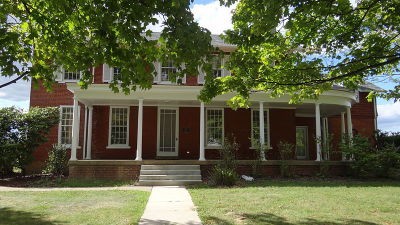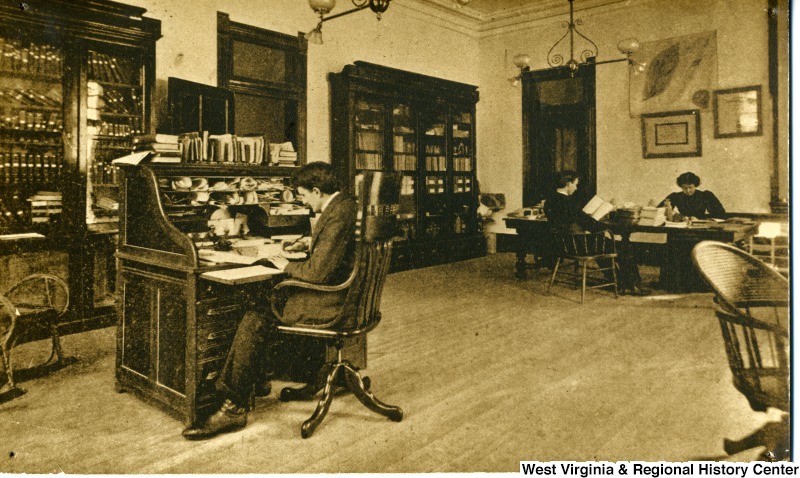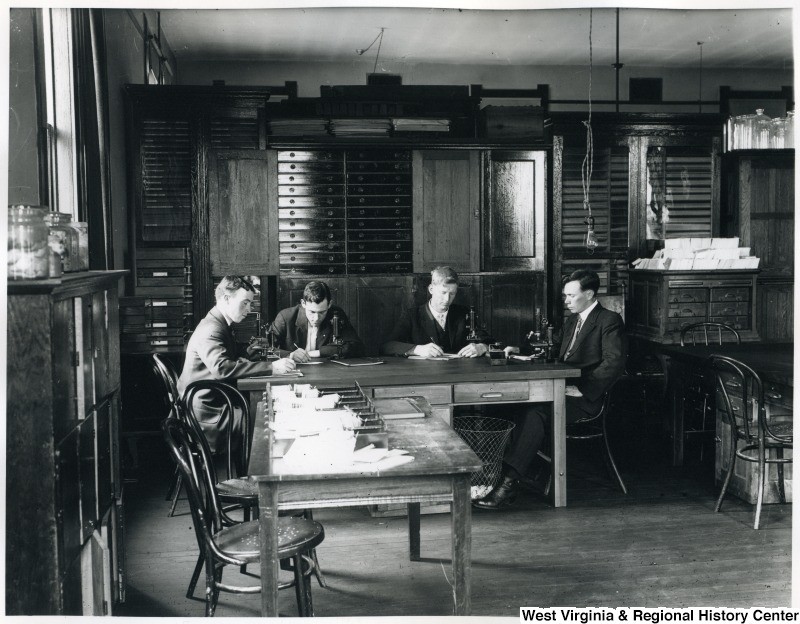The Vance Farmhouse
Introduction
Text-to-speech Audio
Images
The Vance Farmhouse is a classically-designed farmhouse of the mid-nineteenth century.

The Vance Farmhouse shortly after becoming the Agricultural Experiment Station. Photo, 1901, courtesy the West Virginia and Regional History Center, WVU Libraries.

The Horticulture Office of the Agricultural Experiment Station. Photo courtesy the West Virginia and Regional History Center, WVU Libraries.

Entomology, or the study of insects, is important to agriculture. Here, four men take notes and peer through microscopes surrounded by insect collections. Photo courtesy the West Virginia and Regional History Center, WVU Libraries.

Backstory and Context
Text-to-speech Audio
The Vance Farmhouse was built in 1854. The house has gone by different names throughout history - the Vance Farmhouse, the Meeks Farmhouse, Dean's House, and Bicentennial House. These names help tell the story of how one of the last farmhouses in the Morgantown area has changed over time. 1
In 1854, Addison and Mary Vance, along with their children, moved into a new farmhouse along what was then known as Ice's Ferry Road. Although farming was his primary occupation, Addison Vance also served as School Commissioner, helped establish the postal service in Morgantown, operated the National Hotel in Morgantown, and ran for Congress just before building the Farmhouse. The town of Sabraton is named for his daughter, Sabra Vance Sturgiss. The 1860 Census indicates that the Vance Farmhouse was highly valuable and productive, consisting of horses, dairy cows, cattle, pigs, oxen, corn, and oats. In 1879, the Vances sold the farm to their sons-in-law Thomas Jerome Meeks, a coal operator and storekeeper, and Samuel Grove Chadwick, the mayor of Morgantown.2
Meanwhile, West Virginia University was established. Under the Morrill Act, land-grant institutions like West Virginia University emphasized agriculture education. In 1888, the University acquired federal funds through the Hatch Act to create an agriculture experiment station. When their first farm proved unsuccessful, the University purchased the Vance Farmhouse in 1899. Here, students and instructors developed new seed types, improved soil and crops with fertilizers, studied animal husbandry, and formed insect collections. At one point, it also housed a library of 5,500 books. Deans of the College of Agriculture also lived at the farmhouse from 1915 to 1957, giving it the nickname "Dean's House." Afterward, the manager of the University dairy farm resided there. During this time, the Vance Farmhouse was witness to the incredible growth of the University's agriculture program and its influence across the state.3
In 1976, the Vance House helped Morgantown celebrate America's Bicentennial. Earning the nickname the Bicentennial House, it exhibited the history of Monongalia County and garnered wide public attention. After these celebrations, the University used the house as office space for the Mining Extension Service and the Institute for the History of Technology and Industrial Archaeology. Today, the farmhouse, most often called the Bicentennial House, is an administrative office for the West Virginia University Press.4
Farmhouses like the Vance Farmhouse would have dotted the rural landscape of the eastern United States in the eighteenth and nineteenth centuries. Because of their popularity in states like Indiana, Illinois, and Iowa, they are called I-houses. The design is simple: a two-story house that is two rooms wide and one room deep. I-houses are symmetrical, with lots of windows to let in light, a large porch for outdoor seating, and chimneys flanking each end of the house. The Vance Farmhouse has undergone several changes, including interior remodeling, additions, a new roof, and replaced windows on the first floor. Because fire destroyed other farm structures in the 1970s and 1980s, the farmhouse is the last and best remaining structure on site.5
Sources
2. National Park Service, "Vance Farmhouse."
3. National Park Service, "Vance Farmhouse;" West Virginia University. "150th Anniversary - Celebrating Research;" Doherty and Summers, West Virginia University, 52, 99-100.
4. National Park Service, "Vance Farmhouse;" West Virginia University Press, "Get in Touch."
5. Massey and Maxwell, "The I House in Rural America;" National Park Service, "Vance Farmhouse."
Doherty, William T., Jr., and Festus P. Summers. West Virginia University: Symbol of Unity in a Sectionalized State. Morgantown: West Virginia University Press, 1982.
Massey, James C. and Shirley Maxwell. "The I House in Rural America." Old House Journal, May/June 2009. Accessed September 2017. https://www.oldhouseonline.com/articles/the-i-house-in-rural-america
National Park Service, National Register of Historic Places Inventory-Nomination Form. "Vance Farmhouse." Prepared by Lee R. Maddex. Washington, D.C.: National Park Service, 1991. Accessed September 2017. http://www.wvculture.org/shpo/nr/pdf/monongalia/91001731.pdf
West Virginia University. "150th Anniversary - Celebrating Research." Davis College of Agriculture, Natural Resources, and Design. February 14, 2017. Accessed September 2017. http://www.davis.wvu.edu/news/2017/02/14/150th-anniversary-celebrating-research
West Virginia University Press. "Get in Touch." West Virginia University. Accessed September 2017. http://wvupressonline.com/get_in_touch
